Effects of Silicic Acid on Leaching Behavior of Arsenic from Spent Calcium-Based Adsorbents with Arsenite
Abstract
:1. Introduction
2. Materials and Methods
2.1. Spent Ca-Based Adsorbents
2.1.1. Ca-Based Adsorbents (Unspent)
2.1.2. Synthetic As-Contaminated Water
2.1.3. Preparation of Spent Ca-Based Adsorbents
2.2. Silicic Acid Solution
2.3. Shaking Test with Spent Ca-Based Adsorbents and Silicic Acid Solution
3. Results
3.1. pH of Eluate
3.2. As Concentration in Eluate
3.3. Ca Concentration in Eluate
3.4. Total Si-Normalized Concentration in Eluate
3.5. Reproducibility of Experimental Data
4. Discussion
4.1. Relative Evaluation Using As Leaching Ratio
4.2. Dissolved Forms of Siliacic Acid in Liquid
4.3. Dissolved Forms of Arsenous Acid in Liquid
4.4. Stoichiometric Considerations on Spent Ca-Based Adsorbents
4.4.1. Formation Reactions of Calcium Silicate Species
4.4.2. Estimation of Calcium Silicate Species Formed
4.4.3. Effects of Silicic Acid on Leaching Behavior of As(III)
5. Conclusions
Author Contributions
Funding
Institutional Review Board Statement
Informed Consent Statement
Data Availability Statement
Conflicts of Interest
References
- van Geen, A.; Zheng, Y.; Cheng, Z.; Aziz, Z.; Horneman, A.; Dhar, R.K.; Mailloux, B.; Stute, M.; Weinman, B.; Good-bred, S.; et al. A transect of groundwater and sediment properties in Araihazar, Bangladesh: Further evidence of decoupling be-tween As and Fe mobilization. Chem. Geol. 2006, 228, 85–96. [Google Scholar] [CrossRef]
- Harvey, C.F.; Ashfaque, K.N.; Yu, W.; Badruzzaman, A.B.M.; Ali, M.A.; Oates, P.M.; Michael, H.A.; Neumann, R.B.; Beckie, R.; Islam, S.; et al. Groundwater dynamics and arsenic contamination in Bangladesh. Chem. Geol. 2006, 228, 112–136. [Google Scholar] [CrossRef]
- Senanayake, N.; Mukherji, A. Irrigating with arsenic contaminated groundwater in West Bengal and Bangladesh: A review of interventions for mitigating adverse health and crop outcomes. Agric. Water Manag. 2014, 135, 90–99. [Google Scholar] [CrossRef]
- Khan, K.M.; Parvez, F.; Zoeller, R.T.; Hocevar, B.A.; Kamendulis, L.M.; Rohlman, D.; Eunus, M.; Graziano, J. Thyroid hormones and neurobehavioral functions among adolescents chronically exposed to groundwater with geogenic arsenic in Bangladesh. Sci. Total Environ. 2019, 678, 278–287. [Google Scholar] [CrossRef]
- Huq, M.E.; Fahad, S.; Shao, Z.; Sarven, M.S.; Khan, I.A.; Alam, M.; Saeed, M.; Ullah, H.; Adnan, M.; Saud, S.; et al. Arsenic in a groundwater environment in Bangladesh: Occurrence and mobilization. J. Environ. Manag. 2020, 262, 110318. [Google Scholar] [CrossRef]
- Shahid, M.; Niazi, N.K.; Dumat, C.; Naidu, R.; Khalid, S.; Rahman, M.M.; Bibi, I. A meta-analysis of the distribution, sources and health risks of arsenic-contaminated groundwater in Pakistan. Environ. Poll. 2018, 242, 307–319. [Google Scholar] [CrossRef]
- Malik, A.; Parvaiz, A.; Mushtaq, N.; Hussain, I.; Javed, T.; Rehman, H.U.; Farooqi, A. Characterization and role of derived dissolved organic matter on arsenic mobilization in alluvial aquifers of Punjab, Pakistan. Chemosphere 2020, 251, 126374. [Google Scholar] [CrossRef]
- Hamidian, A.H.; Razeghi, N.; Zhang, Y.; Yang, M. Spatial distribution of arsenic in groundwater of Iran, a review. J. Geochem. Explor. 2019, 201, 88–98. [Google Scholar] [CrossRef]
- Chakraborti, D.; Das, B.; Rahman, M.M.; Nayak, B.; Pal, A.; Sengupta, M.K.; Ahamed, S.; Hossain, M.A.; Chowdhury, U.K.; Biswas, B.K.; et al. Arsenic in groundwater of the Kolkata Municipal Corporation (KMC), India: Critical review and modes of mitigation. Chemosphere 2017, 180, 437–447. [Google Scholar] [CrossRef]
- Bhowmick, S.; Pramanik, S.; Singh, P.; Mondal, P.; Chatterjee, D.; Nriagu, J. Arsenic in groundwater of West Bengal, India: A review of human health risks and assessment of possible intervention options. Sci. Total Environ. 2018, 612, 148–169. [Google Scholar] [CrossRef] [PubMed]
- Bindal, S.; Singh, C.K. Predicting groundwater arsenic contamination: Regions at risk in highest populated state of India. Water Res. 2019, 159, 65–76. [Google Scholar] [CrossRef] [PubMed]
- Chandrajith, R.; Diyabalanage, S.; Dissanayake, C.B. Geogenic fluoride and arsenic in groundwater of Sri Lanka and its implications to community health. Groundw. Sustain. Dev. 2020, 10, 100359. [Google Scholar] [CrossRef]
- Hoang, T.H.; Bang, S.; Kim, K.-W.; Nguyen, M.H.; Dang, D.M. Arsenic in groundwater and sediment in the Mekong River delta, Vietnam. Environ. Poll. 2010, 158, 2648–2658. [Google Scholar] [CrossRef]
- Stopelli, E.; Duyen, V.T.; Mai, T.T.; Tran, P.T.K.; Viet, P.H.; Lightfoot, A.; Kipfer, R.; Schneider, M.; Eiche, E.; Kontny, A.; et al. Spatial and temporal evolution of groundwater arsenic contamination in the Red River delta, Vietnam: Interplay of mobilisation and retardation processes. Sci. Total Environ. 2020, 717, 137143. [Google Scholar] [CrossRef] [PubMed]
- Richards, L.A.; Magnone, D.; Sültenfuß, J.; Chambers, L.; Bryant, C.; Boyce, A.J.; van Dongen, B.E.; Ballentine, C.J.; Sovann, C.; Uhlemann, S.; et al. Dual in-aquifer and near surface processes drive arsenic mobilization in Cambodian groundwaters. Sci. Total Environ. 2019, 659, 699–714. [Google Scholar] [CrossRef] [PubMed]
- Wen, D.; Zhang, F.; Zhang, E.; Wang, C.; Han, S.; Zheng, Y. Arsenic, fluoride and iodine in groundwater of China. J. Geochem. Explor. 2013, 135, 1–21. [Google Scholar] [CrossRef] [Green Version]
- Guo, H.; Wen, D.; Liu, Z.; Jia, Y.; Guo, Q. A review of high arsenic groundwater in Mainland and Taiwan, China: Distribution, characteristics and geochemical processes. Appl. Geochem. 2014, 41, 196–217. [Google Scholar] [CrossRef]
- Zhang, L.; Qin, X.; Tang, J.; Liu, W.; Yang, H. Review of arsenic geochemical characteristics and its significance on arsenic pollution studies in karst groundwater, South-west China. Appl. Geochem. 2017, 77, 80–88. [Google Scholar] [CrossRef]
- Mariño, E.E.; Ávila, G.T.; Bhattacharya, P.; Schulz, C.J. The occurrence of arsenic and other trace elements in groundwaters of the southwestern Chaco-Pampean plain, Argentina. J. S. Am. Earth Sci. 2020, 100, 102547. [Google Scholar] [CrossRef]
- Alcaine, A.A.; Schulz, C.; Bundschuh, J.; Jacks, G.; Thunvik, R.; Gustafsson, J.-P.; Mörth, C.-M.; Sracek, O.; Ahmada, A.; Bhattacharya, P. Hydrogeochemical controls on the mobility of arsenic, fluoride and other geogenic co-contaminants in the shallow aquifers of northeastern La Pampa Province in Argentina. Sci. Total Environ. 2020, 715, 136671. [Google Scholar] [CrossRef] [PubMed]
- Machado, I.; Falchi, L.; Bühl, V.; Mañay, N. Arsenic levels in groundwater and its correlation with relevant inorganic parameters in Uruguay: A medical geology perspective. Sci. Total Environ. 2020, 721, 137787. [Google Scholar] [CrossRef] [PubMed]
- Navarro, O.; González, J.; Júnez-Ferreira, H.E.; Bautista, C.-F.; Cardona, A. Correlation of Arsenic and Fluoride in the Groundwater for Human Consumption in a Semiarid Region of Mexico. Procedia Eng. 2017, 186, 333–340. [Google Scholar] [CrossRef]
- Gómez-Hernández, A.; Rodríguez, R.; Río, A.L.; Ruiz-Huerta, E.A.; Armienta, M.A.; Dávila-Harris, P.; Sen-Gupta, B.; Delgado-Rodríguez, O.; Ríos, A.D.A.; Martínez-Villegas, N. Alluvial and gypsum karst geological transition favors spreading arsenic contamination in Matehuala, Mexico. Sci. Total Environ 2020, 707, 135340. [Google Scholar] [CrossRef]
- Bretzler, A.; Lalanne, F.; Nikiema, J.; Podgorski, J.; Pfenninger, N.; Berg, M.; Schirmer, M. Groundwater arsenic contamination in Burkina Faso, West Africa: Predicting and verifying regions at risk. Sci. Total Environ. 2017, 584–585, 958–970. [Google Scholar] [CrossRef] [PubMed]
- Abiye, T.A.; Bhattacharya, P. Arsenic concentration in groundwater: Archetypal study from South Africa. Groundw. Sustain. Dev. 2019, 9, 100246. [Google Scholar] [CrossRef]
- Podgorski, J.; Berg, M. Global threat of arsenic in groundwater. Science 2020, 368, 845–850. [Google Scholar] [CrossRef] [PubMed]
- Shaji, E.; Santosh, M.; Sarath, K.V.; Prakash, P.; Deepch, V.; Divy, B.V. Arsenic contamination of groundwater: A global synopsis with focus on the Indian Peninsula. Geosci. Front. 2021, 13, 101079. [Google Scholar] [CrossRef]
- Jadhav, S.V.; Bringas, E.; Yadav, G.D.; Rathod, V.K.; Ortiz, I.; Marathe, K.V. Arsenic and fluoride contaminated groundwaters: A review of current technologies for contaminants removal. J. Environ. Manag. 2015, 162, 306–325. [Google Scholar] [CrossRef]
- Sarkar, A.; Paul, B. The global menace of arsenic and its conventional remediation-A critical review. Chemosphere 2016, 158, 37–49. [Google Scholar] [CrossRef]
- Ghosh, S.; Debsarkar, A.; Dutta, A. Technology alter-natives for decontamination of arsenic-rich groundwater—A critical review, Environ. Technol. Innov. 2019, 13, 277–303. [Google Scholar] [CrossRef]
- Kumar, R.; Patel, M.; Singh, P.; Bundschuh, J.; Pittman, C.U., Jr.; Trakal, L.; Mohan, D. Emerging technologies for arsenic removal from drinking water in rural and peri-urban areas: Methods, experience from, and options for Latin America. Sci. Total Environ. 2019, 694, 133427. [Google Scholar] [CrossRef] [PubMed]
- Opiso, E.M.; Sato, T.; Morimoto, K.; Asai, A.; Anraku, S.; Numako, C.; Yoneda, T. Incorporation of arsenic during the formation of Mg-bearing minerals at alkaline condition. Miner. Eng. 2010, 23, 230–237. [Google Scholar] [CrossRef]
- Park, Y.Y.; Tran, T.; Lee, Y.H.; Nam, Y., II; Senanayake, G.; Kim, M.J. Selective removal of arsenic(V) from a molybdate plant liquor by precipitation of magnesium arsenate. Hydrometallurgy 2010, 104, 290–297. [Google Scholar] [CrossRef] [Green Version]
- Tresintsi, S.; Simeonidis, K.; Katsikini, M.; Paloura, E.C.; Bantsis, G.; Mitrakas, M. A novel approach for arsenic adsorbents regeneration using MgO. J. Hazard. Mater. 2014, 265, 217–225. [Google Scholar] [CrossRef] [PubMed] [Green Version]
- Camacho, J.; Wee, H.-Y.; Kramer, T.A.; Autenrieth, R. Arsenic stabilization on water treatment residuals by calcium addition. J. Hazard. Mater. 2009, 165, 599–603. [Google Scholar] [CrossRef] [PubMed]
- Montes-Hernandeza, G.; Concha-Lozan, N.; Renard, F.; Quirico, E. Removal of oxyanions from synthetic wastewater via carbonation process of calcium hydroxide: Applied and fundamental aspects. J. Hazard. Mater. 2009, 166, 788–795. [Google Scholar] [CrossRef]
- Olyaie, E.; Banejad, H.; Afkhami, A.; Rahmani, A.; Khodaveisi, J. Development of a cost-effective technique to remove the arsenic contamination from aqueous solutions by calcium peroxide nanoparticles. Sep. Purif. Technol. 2012, 95, 10–15. [Google Scholar] [CrossRef]
- Hua, C.-Y.; Lo, S.-L.; Kuan, W.-H. High concentration of arsenate removal by electrocoagulation with calcium. Sep. Purif. Technol. 2014, 126, 7–14. [Google Scholar] [CrossRef]
- Sugita, H.; Oguma, T.; Zhang, M.; Hara, J.; Takahashi, S. Environmental stability of spent magnesium-based and calcium-based arsenic adsorbents-Effects of soils. J. Jpn. Soc. Civ. Eng. Ser. G Environ. Res. 2016, 72, 437–448. [Google Scholar] [CrossRef] [Green Version]
- Sugita, H.; Oguma, T.; Zhang, M.; Hara, J.; Kawabe, Y. Effects of silicic acid on environmental stability of spent magnesium-based arsenic adsorbents. J. Jpn. Soc. Civ. Eng. Ser. G Environ. Res. 2017, 73, 407–418. [Google Scholar] [CrossRef]
- Sugita, H.; Oguma, T.; Zhang, M.; Hara, J.; Kawabe, Y. Effects of silicic acid on environmental stability of spent calcium-based arsenic adsorbents. J. Jpn. Soc. Civ. Eng. Ser. G Environ. Res. 2018, 74, 493–502. [Google Scholar] [CrossRef]
- Sugita, H.; Oguma, T.; Hara, J.; Zhang, M.; Kawabe, Y. Effects of solution pH on spent Mg-based and Ca-based adsorbents -leaching behavior of arsenite and arsenate acids. Jpn. Geotech. J. 2020, 15, 441–453. [Google Scholar] [CrossRef]
- The Chemical Society of Japan (CSJ). Kagaku Binran (Handbook of Chemistry), Pure Chemistry II, 4th ed.; Maruzen: Tokyo, Japan, 1993; p. 317. [Google Scholar]
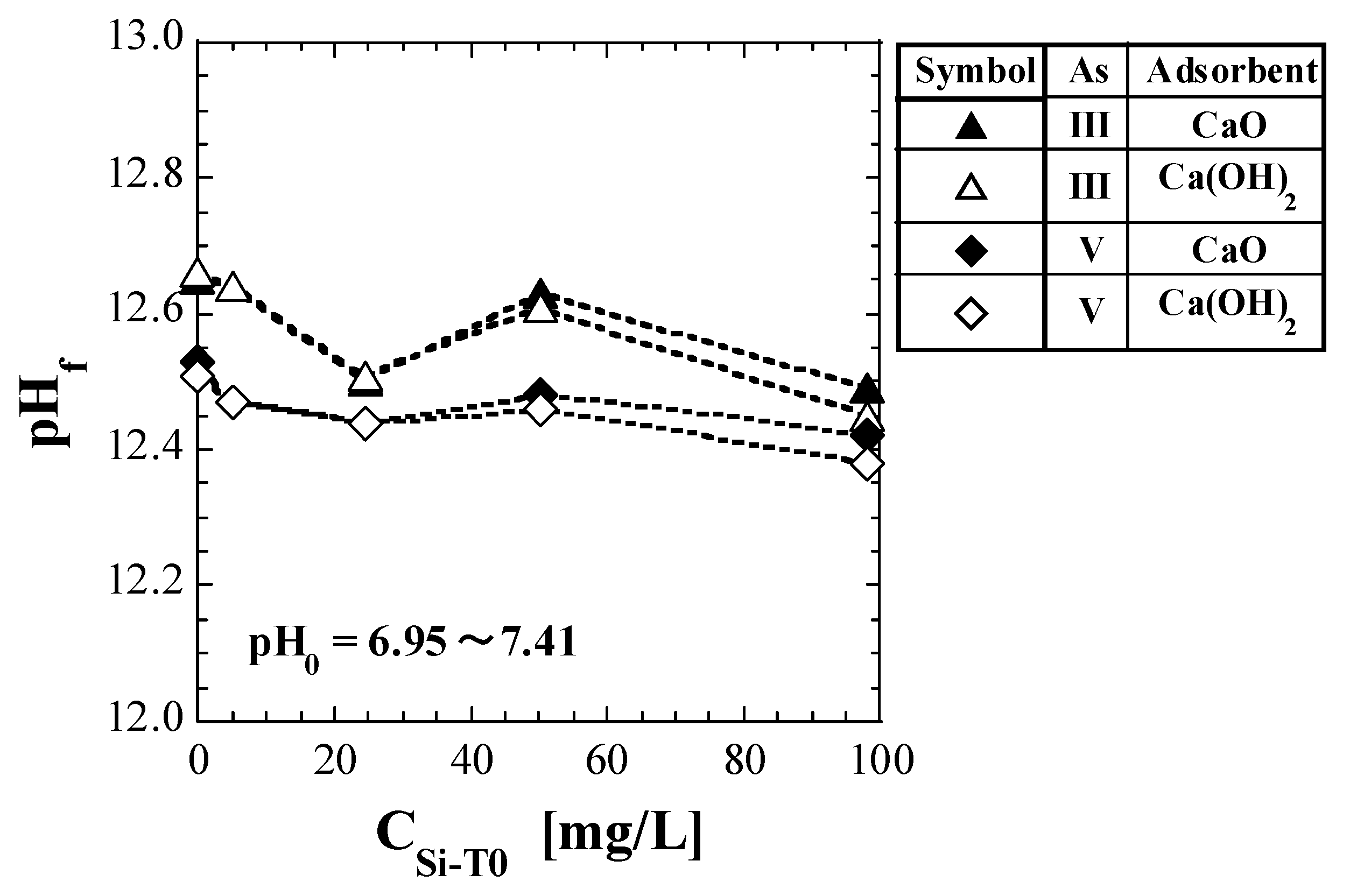
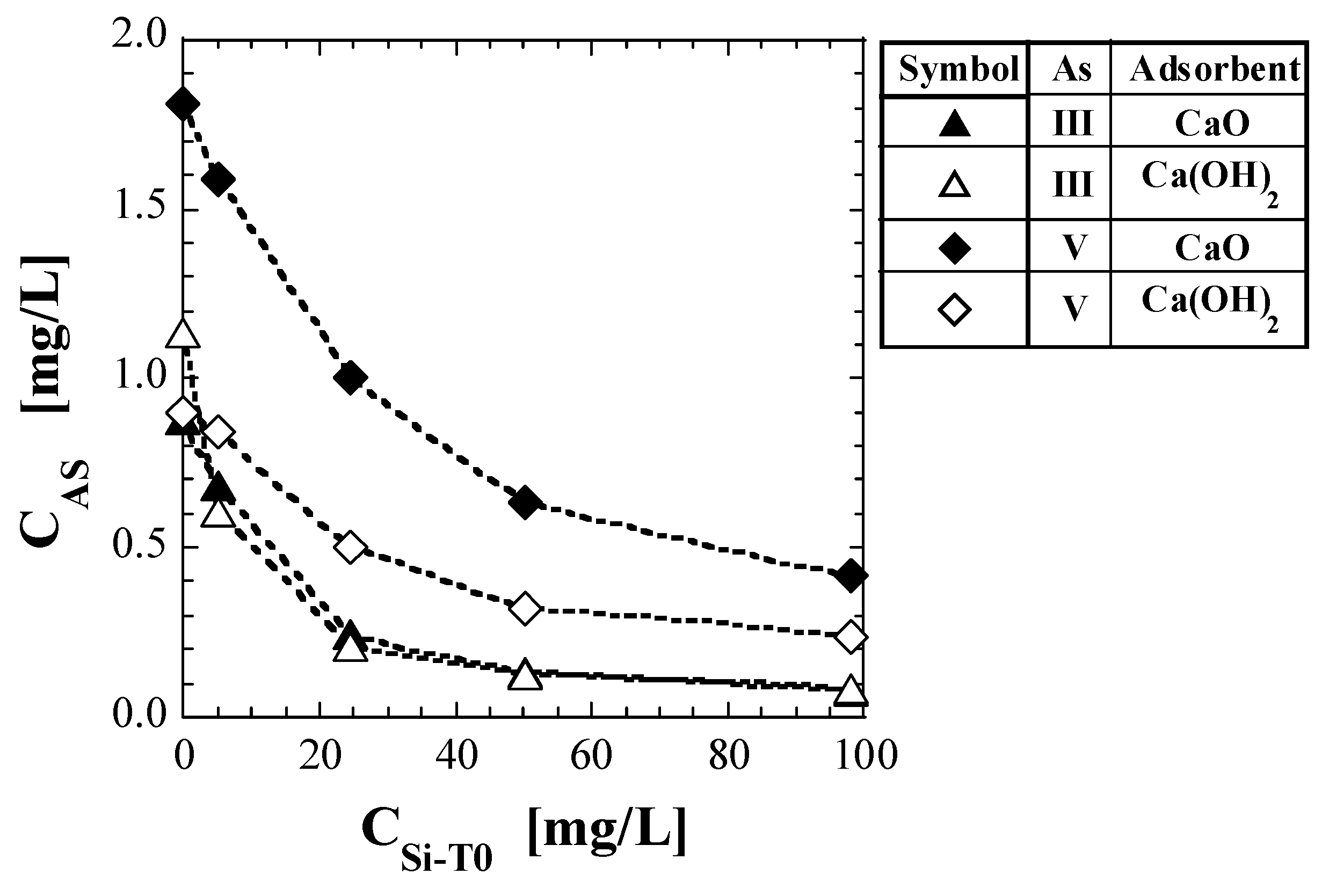
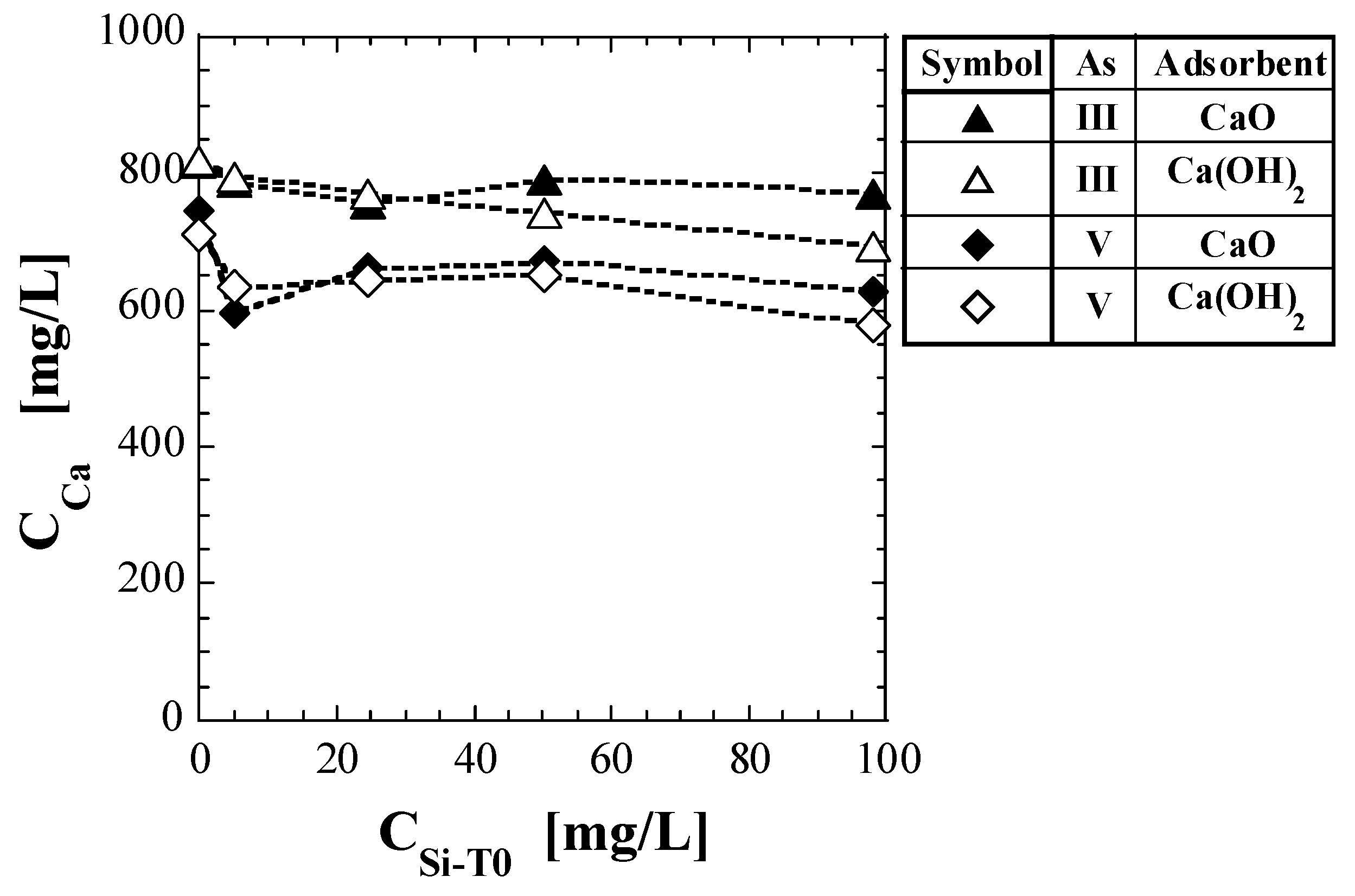
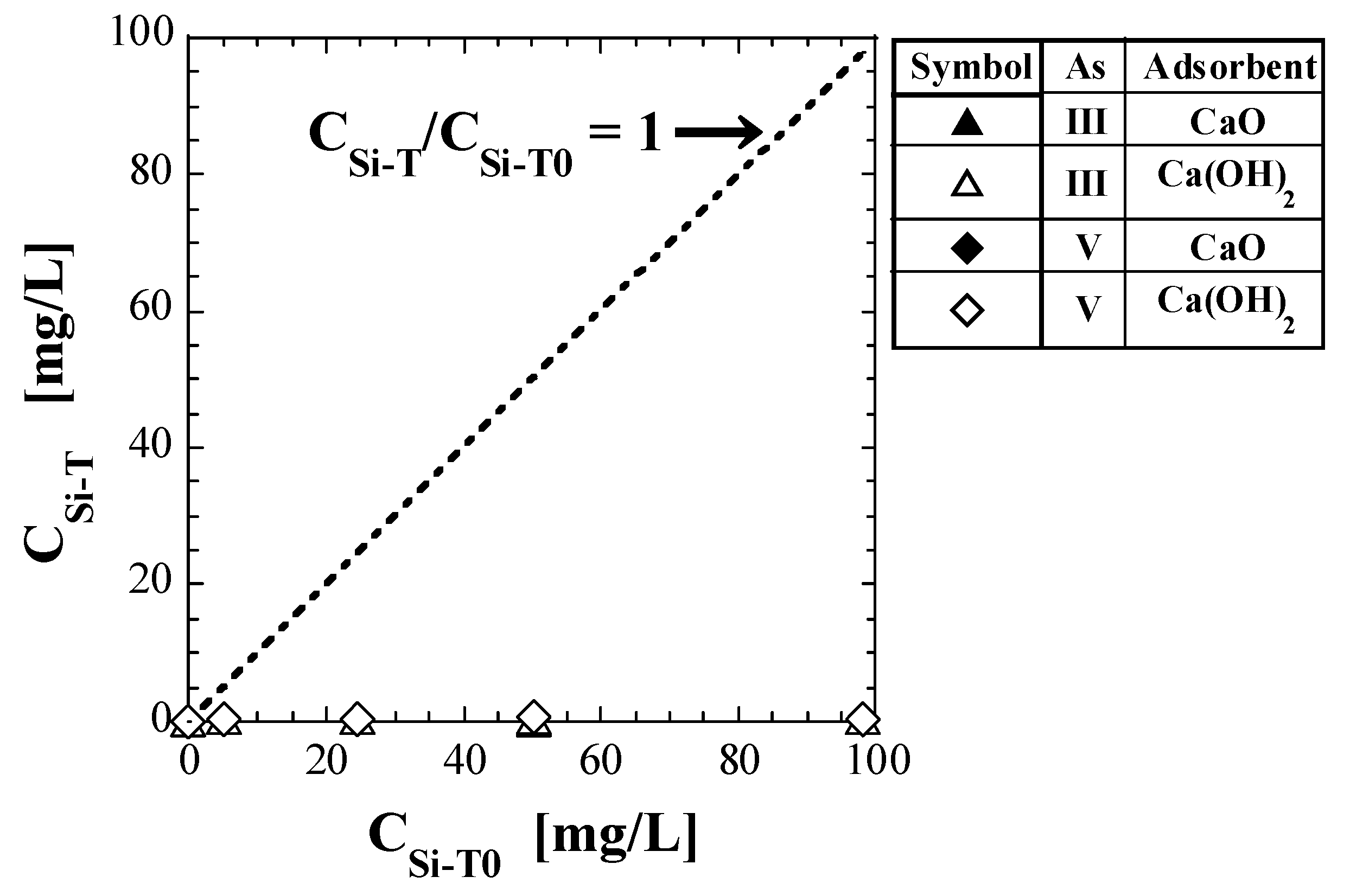
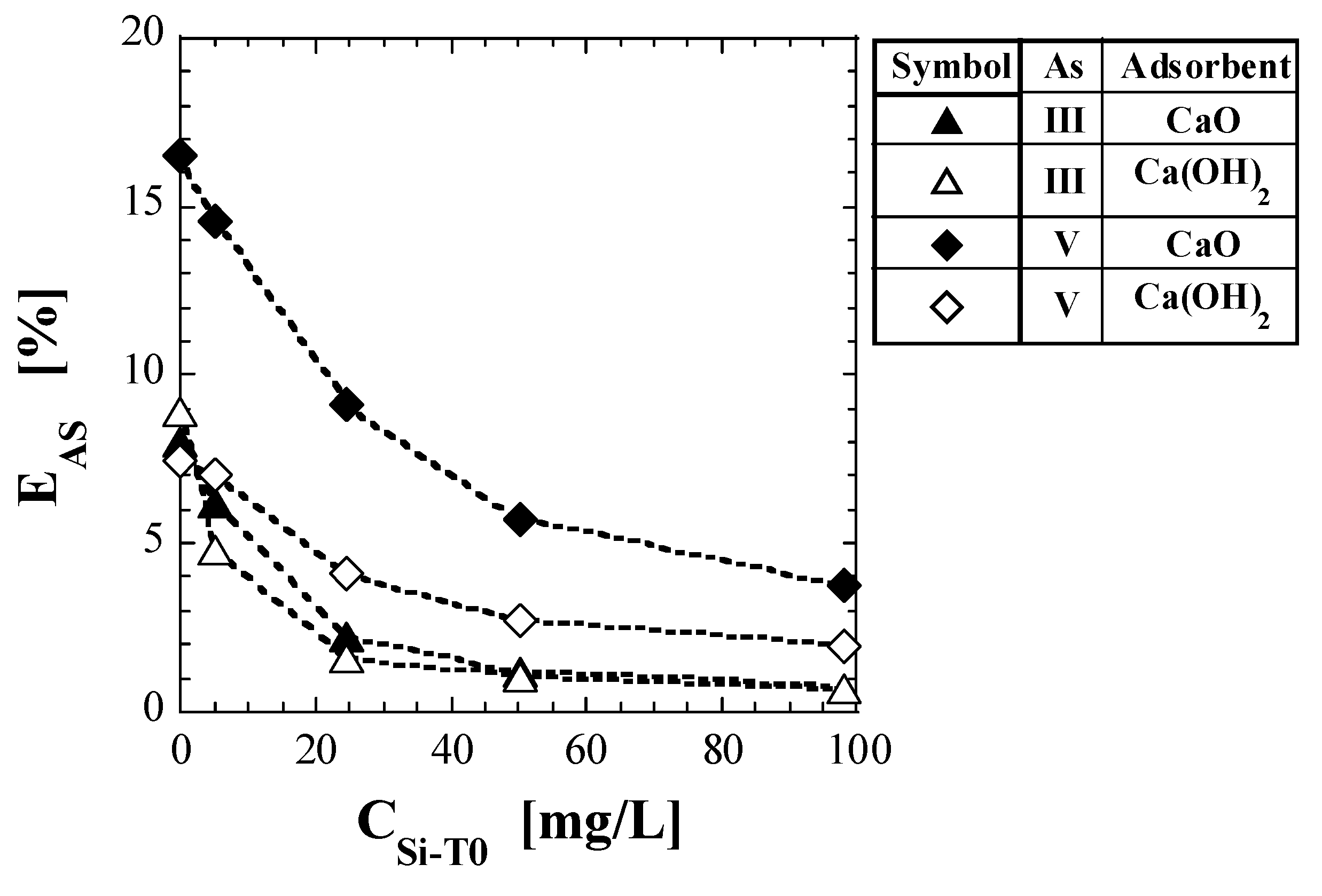
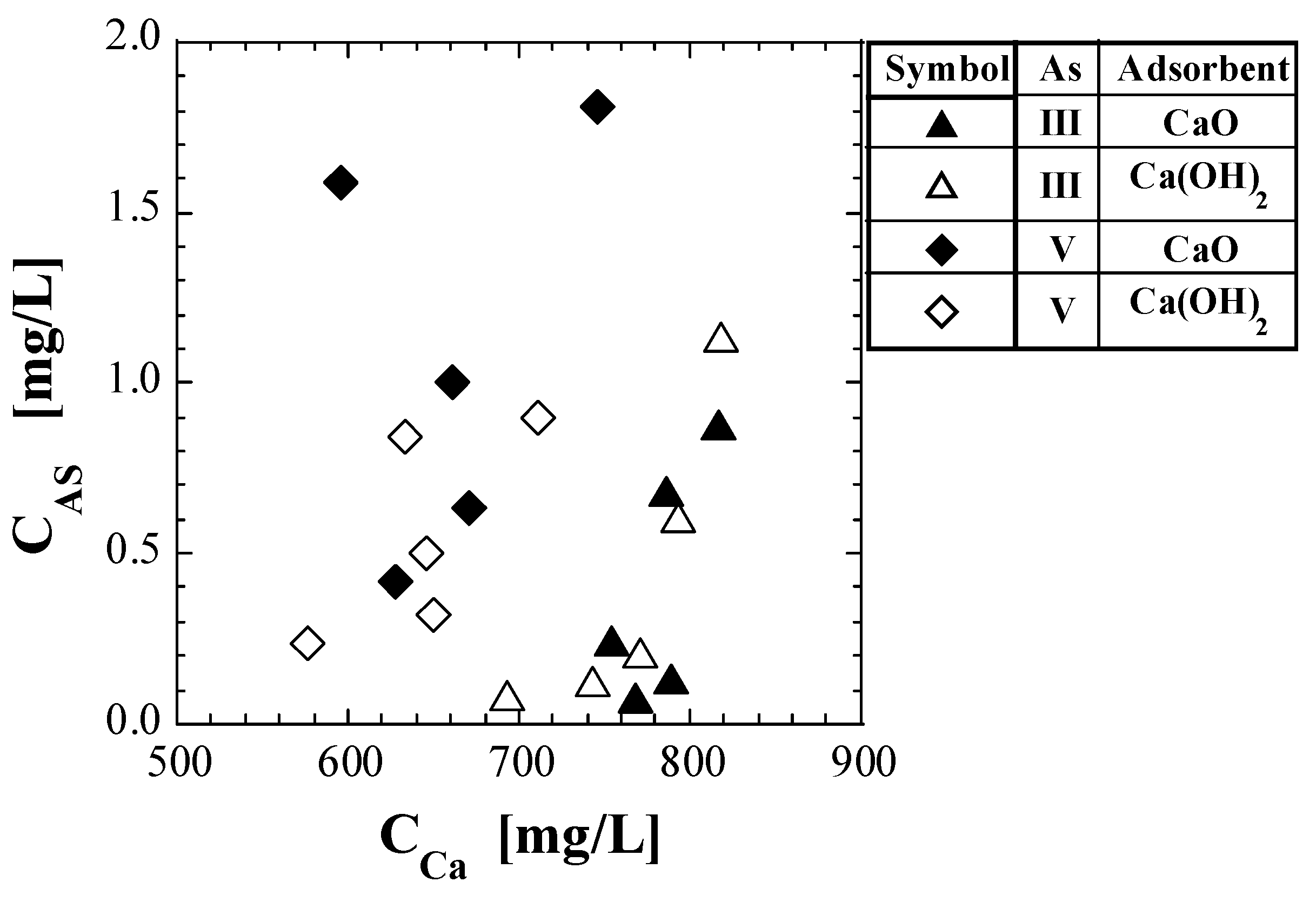

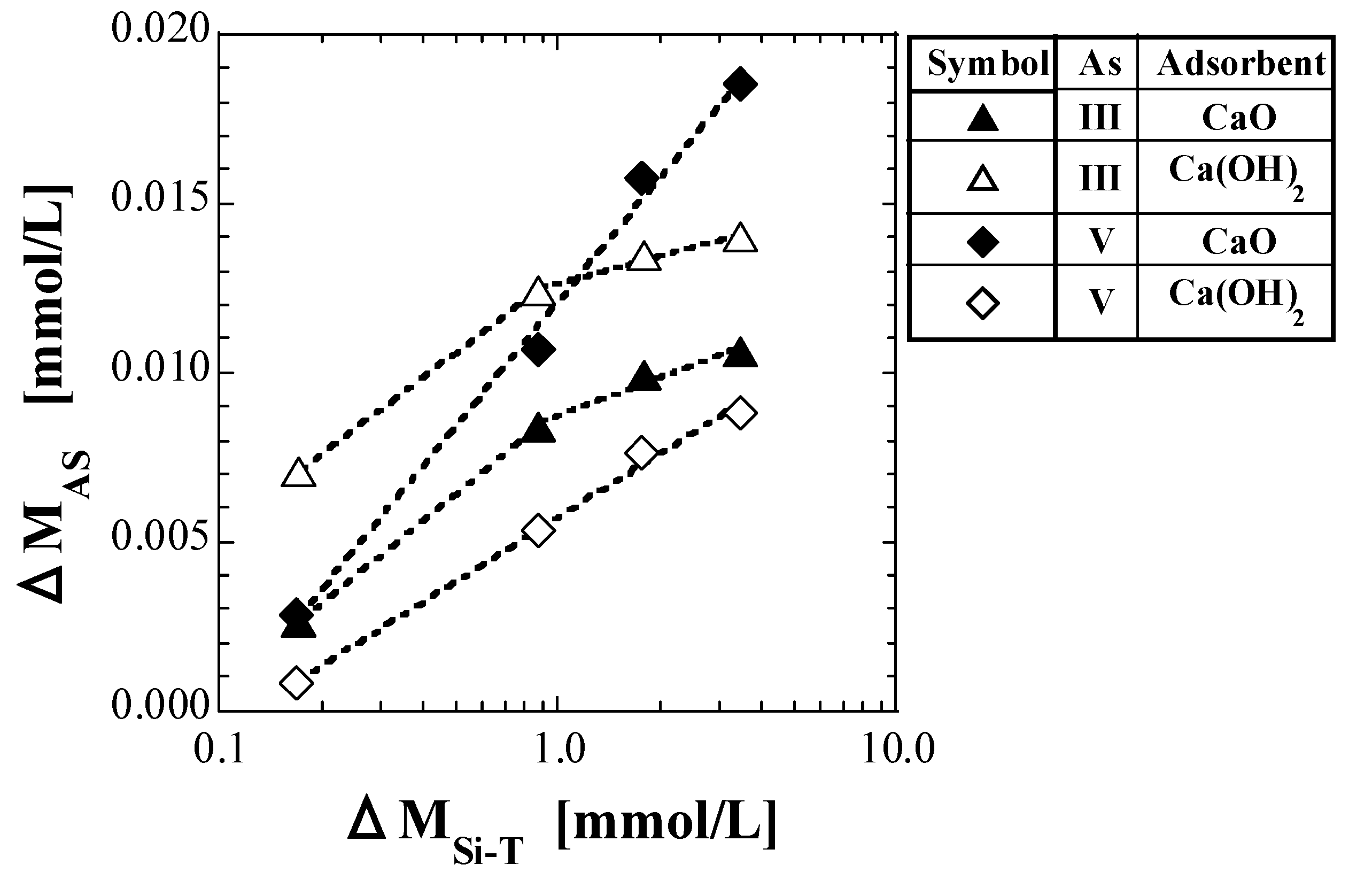
| No. | Adsorbent | As(Valence) | WAD/V [mg/L] | pH0 | CAS0 [mg/L] | CAS [mg/L] | RAS [%] |
|---|---|---|---|---|---|---|---|
| (1) 1 | CaO | As(III) | 5009 | 7.09 | 22.347 | 1.437 | 93.6 |
| (2) 1 | Ca(OH)2 | As(III) | 5009 | 7.09 | 22.725 | 1.378 | 93.9 |
| (3) 2 | CaO | As(V) | 5013 | 7.58 | 20.085 | 0.093 | 99.5 |
| (4) 2 | Ca(OH)2 | As(V) | 5014 | 7.58 | 20.563 | 0.737 | 96.4 |
| No. | Adsorbent | As(Valence) | αCa [%] | WCa/V [mg/L] | CCa [mg/L] | βCa [%] |
|---|---|---|---|---|---|---|
| (1) 1 | CaO | As(III) | 71.19 | 3566 | 837 | 23.5 |
| (2) 1 | Ca(OH)2 | As(III) | 53.51 | 2680 | 858 | 32.0 |
| (3) 2 | CaO | As(V) | 71.19 | 3569 | 965 | 27.0 |
| (4) 2 | Ca(OH)2 | As(V) | 53.51 | 2683 | 903 | 33.7 |
| No. | Adsorbent | As(valence) | QAS [mg-As/L] |
|---|---|---|---|
| (1) 1 | CaO | As(III) | 5.42 |
| (2) 1 | Ca(OH)2 | As(III) | 6.23 |
| (3) 2 | CaO | As(V) | 5.44 |
| (4) 2 | Ca(OH)2 | As(V) | 5.93 |
| Si-Normalized Concentration | CSi-T0 [mg/L] | CSi-M0 [mg/L] | CSi-P0 [mg/L] | pH0 |
|---|---|---|---|---|
| 0 mg/L | 0 | 0 | 0 | 7.05 |
| 5 mg/L | 4.93 | 4.90 | 0.03 | 7.18 |
| 25 mg/L | 24.7 | 23.0 | 1.71 | 6.95 |
| 50 mg/L | 50.4 | 50.0 | 0.38 | 7.15 |
| 100 mg/L | 98.0 | 84.7 | 13.3 | 7.41 |
| CSi-T0 [mg/L] | |||||||
|---|---|---|---|---|---|---|---|
| No. | Adsorbent | As(Valence) | 0 | 5 | 25 | 50 | 100 |
| (1) | CaO | As(III) | 12.65 | 12.64 | 12.50 | 12.63 | 12.49 |
| (2) | Ca(OH)2 | As(III) | 12.66 | 12.64 | 12.51 | 12.61 | 12.45 |
| (3) 1 | CaO | As(V) | 12.53 | 12.47 | 12.44 | 12.48 | 12.42 |
| (4) 1 | Ca(OH)2 | As(V) | 12.51 | 12.47 | 12.44 | 12.46 | 12.38 |
| CSi-T0 [mg/L] | |||||||
|---|---|---|---|---|---|---|---|
| No. | Adsorbent | As(valence) | 0 | 5 | 25 | 50 | 100 |
| (1) | CaO | As(III) | 0.874 | 0.680 | 0.246 | 0.130 | 0.076 |
| (2) | Ca(OH)2 | As(III) | 1.135 | 0.606 | 0.205 | 0.127 | 0.086 |
| (3) 1 | CaO | As(V) | 1.807 | 1.592 | 1.005 | 0.626 | 0.416 |
| (4) 1 | Ca(OH)2 | As(V) | 0.895 | 0.836 | 0.498 | 0.323 | 0.233 |
| CSi-T0 [mg/L] | |||||||
|---|---|---|---|---|---|---|---|
| No. | Adsorbent | As(valence) | 0 | 5 | 25 | 50 | 100 |
| (1) | CaO | As(III) | 817 | 786 | 754 | 789 | 768 |
| (2) | Ca(OH)2 | As(III) | 818 | 794 | 771 | 743 | 693 |
| (3) 1 | CaO | As(V) | 745 | 595 | 661 | 671 | 628 |
| (4) 1 | Ca(OH)2 | As(V) | 712 | 633 | 646 | 650 | 576 |
| CSi-T0 [mg/L] | |||||||
|---|---|---|---|---|---|---|---|
| No. | Adsorbent | As(valence) | 0 | 5 | 25 | 50 | 100 |
| (1) | CaO | As(III) | 0.00 | 0.16 | 0.23 | 0.06 | 0.23 |
| (2) | Ca(OH)2 | As(III) | 0.00 | 0.17 | 0.23 | 0.14 | 0.26 |
| (3) 1 | CaO | As(V) | 0.00 | 0.28 | 0.28 | 0.49 | 0.40 |
| (4) 1 | Ca(OH)2 | As(V) | 0.00 | 0.29 | 0.23 | 0.53 | 0.39 |
| EAS [%] | |||||||
|---|---|---|---|---|---|---|---|
| No. | Adsorbent | As(valence) | 0 | 5 | 25 | 50 | 100 |
| (1) | CaO | As(III) | 8.00 | 6.17 | 2.23 | 1.19 | 0.695 |
| (2) | Ca(OH)2 | As(III) | 8.89 | 4.81 | 1.62 | 1.01 | 0.670 |
| (3) 1 | CaO | As(V) | 16.5 | 14.6 | 9.13 | 5.70 | 3.78 |
| (4) 1 | Ca(OH)2 | As(V) | 7.43 | 7.00 | 4.13 | 2.71 | 1.94 |
| CSi-T0 [mg/L] | ||||||
|---|---|---|---|---|---|---|
| No. | Adsorbent | As(valence) | 5 | 25 | 50 | 100 |
| (1) | CaO | As(III) | 4.43 | 1.79 | 0.38 | 0.35 |
| (2) | Ca(OH)2 | As(III) | 3.58 | 1.35 | 1.05 | 0.90 |
| (3) 1 | CaO | As(V) | 22.1 | 2.42 | 1.05 | 0.84 |
| (4) 1 | Ca(OH)2 | As(V) | 11.6 | 1.89 | 0.87 | 0.97 |
| CSi-T0 [mg/L] | ||||
|---|---|---|---|---|
| No. | Adsorbent | As(valence) | 5–25 | 25–100 |
| (1) | CaO | As(III) | 0.00817 | 0.00377 |
| (2) | Ca(OH)2 | As(III) | 0.00755 | 0.00267 |
| (3) 1 | CaO | As(V) | 0.0122 | |
| (4) 1 | Ca(OH)2 | As(V) | 0.00628 | |
| CSi-T0 [mg/L] | ||||
|---|---|---|---|---|
| No. | Adsorbent | As(valence) | 5–25 | 25–100 |
| (1) | CaO | As(III) | 0.00888 | 0.00873 |
| (2) | Ca(OH)2 | As(III) | 0.0129 | 0.0126 |
| (3) 1 | CaO | As(V) | 0.0121 | |
| (4) 1 | Ca(OH)2 | As(V) | 0.00571 | |
Publisher’s Note: MDPI stays neutral with regard to jurisdictional claims in published maps and institutional affiliations. |
© 2021 by the authors. Licensee MDPI, Basel, Switzerland. This article is an open access article distributed under the terms and conditions of the Creative Commons Attribution (CC BY) license (https://creativecommons.org/licenses/by/4.0/).
Share and Cite
Sugita, H.; Oguma, T.; Hara, J.; Zhang, M.; Kawabe, Y. Effects of Silicic Acid on Leaching Behavior of Arsenic from Spent Calcium-Based Adsorbents with Arsenite. Sustainability 2021, 13, 12937. https://doi.org/10.3390/su132312937
Sugita H, Oguma T, Hara J, Zhang M, Kawabe Y. Effects of Silicic Acid on Leaching Behavior of Arsenic from Spent Calcium-Based Adsorbents with Arsenite. Sustainability. 2021; 13(23):12937. https://doi.org/10.3390/su132312937
Chicago/Turabian StyleSugita, Hajime, Terumi Oguma, Junko Hara, Ming Zhang, and Yoshishige Kawabe. 2021. "Effects of Silicic Acid on Leaching Behavior of Arsenic from Spent Calcium-Based Adsorbents with Arsenite" Sustainability 13, no. 23: 12937. https://doi.org/10.3390/su132312937
APA StyleSugita, H., Oguma, T., Hara, J., Zhang, M., & Kawabe, Y. (2021). Effects of Silicic Acid on Leaching Behavior of Arsenic from Spent Calcium-Based Adsorbents with Arsenite. Sustainability, 13(23), 12937. https://doi.org/10.3390/su132312937






